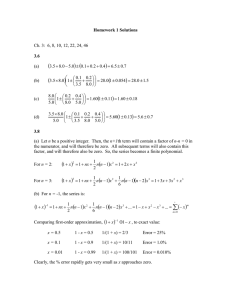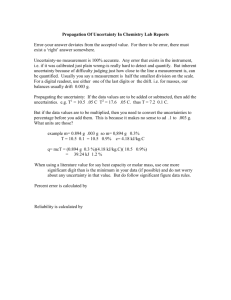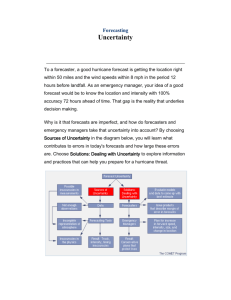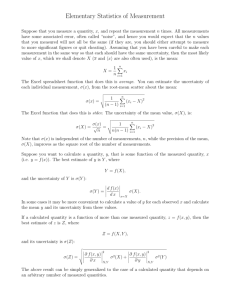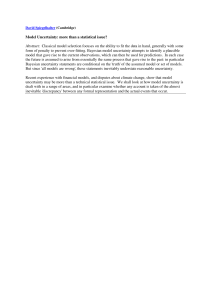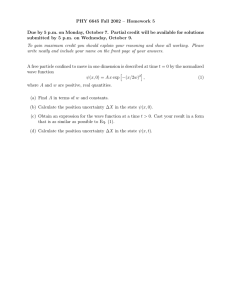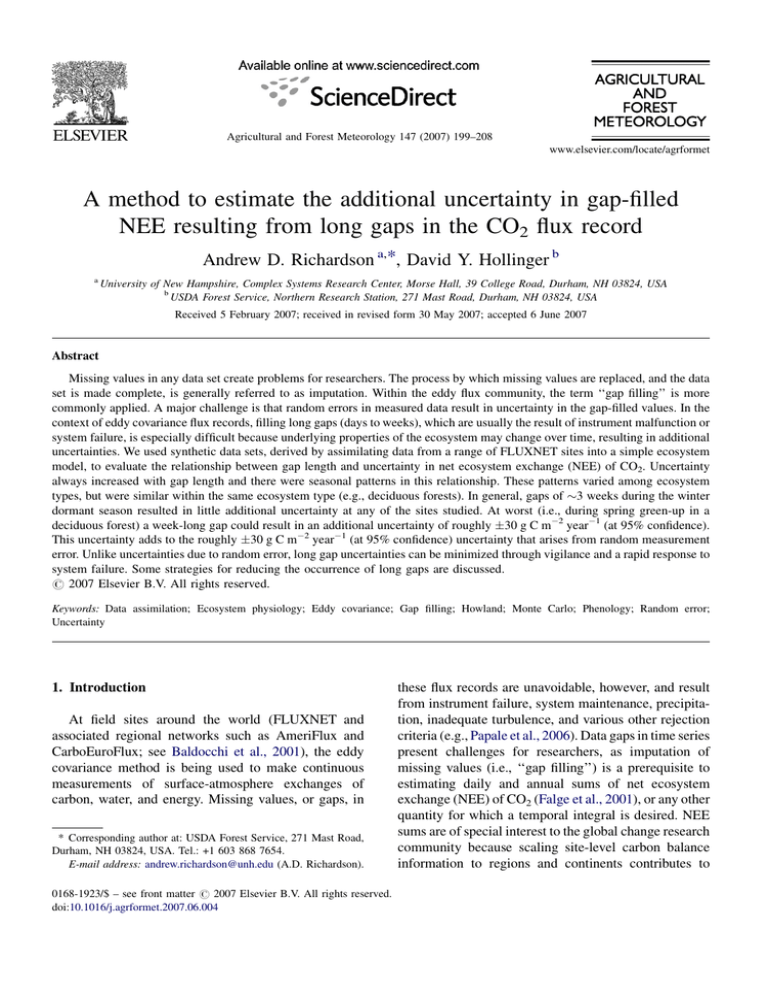
Agricultural and Forest Meteorology 147 (2007) 199–208
www.elsevier.com/locate/agrformet
A method to estimate the additional uncertainty in gap-filled
NEE resulting from long gaps in the CO2 flux record
Andrew D. Richardson a,*, David Y. Hollinger b
a
University of New Hampshire, Complex Systems Research Center, Morse Hall, 39 College Road, Durham, NH 03824, USA
b
USDA Forest Service, Northern Research Station, 271 Mast Road, Durham, NH 03824, USA
Received 5 February 2007; received in revised form 30 May 2007; accepted 6 June 2007
Abstract
Missing values in any data set create problems for researchers. The process by which missing values are replaced, and the data
set is made complete, is generally referred to as imputation. Within the eddy flux community, the term ‘‘gap filling’’ is more
commonly applied. A major challenge is that random errors in measured data result in uncertainty in the gap-filled values. In the
context of eddy covariance flux records, filling long gaps (days to weeks), which are usually the result of instrument malfunction or
system failure, is especially difficult because underlying properties of the ecosystem may change over time, resulting in additional
uncertainties. We used synthetic data sets, derived by assimilating data from a range of FLUXNET sites into a simple ecosystem
model, to evaluate the relationship between gap length and uncertainty in net ecosystem exchange (NEE) of CO2. Uncertainty
always increased with gap length and there were seasonal patterns in this relationship. These patterns varied among ecosystem
types, but were similar within the same ecosystem type (e.g., deciduous forests). In general, gaps of 3 weeks during the winter
dormant season resulted in little additional uncertainty at any of the sites studied. At worst (i.e., during spring green-up in a
deciduous forest) a week-long gap could result in an additional uncertainty of roughly 30 g C m2 year1 (at 95% confidence).
This uncertainty adds to the roughly 30 g C m2 year1 (at 95% confidence) uncertainty that arises from random measurement
error. Unlike uncertainties due to random error, long gap uncertainties can be minimized through vigilance and a rapid response to
system failure. Some strategies for reducing the occurrence of long gaps are discussed.
# 2007 Elsevier B.V. All rights reserved.
Keywords: Data assimilation; Ecosystem physiology; Eddy covariance; Gap filling; Howland; Monte Carlo; Phenology; Random error;
Uncertainty
1. Introduction
At field sites around the world (FLUXNET and
associated regional networks such as AmeriFlux and
CarboEuroFlux; see Baldocchi et al., 2001), the eddy
covariance method is being used to make continuous
measurements of surface-atmosphere exchanges of
carbon, water, and energy. Missing values, or gaps, in
* Corresponding author at: USDA Forest Service, 271 Mast Road,
Durham, NH 03824, USA. Tel.: +1 603 868 7654.
E-mail address: andrew.richardson@unh.edu (A.D. Richardson).
0168-1923/$ – see front matter # 2007 Elsevier B.V. All rights reserved.
doi:10.1016/j.agrformet.2007.06.004
these flux records are unavoidable, however, and result
from instrument failure, system maintenance, precipitation, inadequate turbulence, and various other rejection
criteria (e.g., Papale et al., 2006). Data gaps in time series
present challenges for researchers, as imputation of
missing values (i.e., ‘‘gap filling’’) is a prerequisite to
estimating daily and annual sums of net ecosystem
exchange (NEE) of CO2 (Falge et al., 2001), or any other
quantity for which a temporal integral is desired. NEE
sums are of special interest to the global change research
community because scaling site-level carbon balance
information to regions and continents contributes to
200
A.D. Richardson, D.Y. Hollinger / Agricultural and Forest Meteorology 147 (2007) 199–208
improved models and understanding of the global carbon
cycle (Wofsy and Harriss, 2002).
Uncertainty in annual NEE can be attributed to
systematic errors and biases (Goulden et al., 1996;
Moncrieff et al., 1996; Loescher et al., 2006), which we
will not consider here, as well as random measurement
errors (Hollinger and Richardson, 2005; Richardson
et al., 2006a) and uncertainties due to gap filling. One
study reported that for a selection of eddy flux sites,
data coverage for a given year averaged 65%, with a
range between 90% and 40% (Falge et al., 2001).
Previous efforts to quantify the uncertainty due to gap
filling have used Monte Carlo techniques to determine
the effect of random measurement errors on uncertainty
in the parameterization of the gap-filling model (e.g.,
Richardson and Hollinger, 2005), which leads to
uncertainty in the predicted values used to fill gaps.
However, this approach ignores an additional, and
potentially significant, source of uncertainty; because
gaps are not distributed randomly throughout the year,
long gaps (days to weeks), which are usually attributed
to instrument failure, tend to be more common than
would be expected by chance alone. It is generally
acknowledged that long gaps are more difficult to fill
than short gaps (Falge et al., 2001; Richardson et al.,
2006c; Moffat et al., in review), because key ecosystem
properties may change over time, thus creating a nonstationary time series. For example, previous studies
have documented seasonal variation in canopy-level
photosynthetic capacity (Hollinger et al., 2004), as well
as the temperature sensitivity of respiration (Reichstein
et al., 2005), and the relative contribution of soil
respiration to ecosystem respiration (Davidson et al.,
2006). Numerous factors can be invoked to explain
changes in ecosystem function, including phenology
(e.g., canopy green-up and senescence), physiological
acclimation, indirect or lagged effects of climate, step
changes in environmental factors (e.g., soil frost or
snow melt) and even pest outbreaks or other
disturbances. From the perspective of filling long gaps,
the real problem is that without any data, it is
impossible to know exactly how the ecosystem
properties might have changed during the gap, a
classic problem of known unknowns. For example, in
temperate systems, a long gap in early spring could be
especially problematic, because the dates at which
photosynthetic uptake commenced, or the system
changed from a carbon source to a carbon sink, would
be unknown. Thus, long gaps may add considerable
uncertainty to gap-filled estimates of annual NEE, but
to date the uncertainty due to long gaps has yet to be
quantified.
Here we describe a method to quantify the
uncertainties in annual NEE that are due both to
random measurement error and to gap filling, including
the additional uncertainty that can be attributed to long
gaps. CO2 flux data from a coniferous, two deciduous,
two mixed species, and two Mediterranean sites, are
combined with a simple model using data assimilation
techniques (Gove and Hollinger, 2006) to generate
synthetic, gap-free, time series. Using these synthetic
data, we first determine the uncertainty in gap-filled
NEE that can be attributed to random measurement
errors, using a standard Monte Carlo approach. We then
use an iterative, systematic procedure to determine
relationships between gap length and starting date on
NEE uncertainty, and use these relationships to estimate
the additional uncertainty due specifically to long gaps.
For each site–year of data, we present estimates of the
total uncertainty in NEE that can be attributed to these
two sources.
2. Data and method
2.1. Data sources
For this analysis, we used half-hourly eddy flux
measurements of the net ecosystem exchange of CO2
from four different ecosystem types (Table 1): (1) a
spruce-dominated forest at the southern ecotone of the
boreal forest (Howland, Maine, USA: 45.258N,
68.738W, Hollinger et al., 2004); (2) two beechdominated temperate deciduous forests (Hesse, France:
48.678N, 7.058E, Granier et al., 2000; Hainich,
Germany: 51.078N, 10.458E, Knohl et al., 2003); (3)
a mixed beech/Douglas-fir forest (Vielsalm, Belgium;
50.308N, 5.988E, Aubinet et al., 2001); and (4) two oakdominated Mediterranean forests (Roccarespampani,
Italy: 42.408N, 11.928E, Tedeschi et al., 2006;
Puechabon, France: 43.738N, 3.588E, Rambal et al.,
2004). Quality control, flux corrections, and data editing
were performed by the individual site investigators.
Nocturnal data were filtered with site-specific u* values
(see Hollinger et al., 2004; Reichstein et al., 2005;
Papale et al., 2006). Data from the European sites were
assembled as part of a comprehensive evaluation of a
standardized data processing algorithm (Papale et al.,
2006) and a comparison of gap-filling techniques
(Moffat et al., in review).
2.2. Development of synthetic data sets
Flux data were assimilated, on a site-by-site basis,
into a simple ecosystem physiology model using an
A.D. Richardson, D.Y. Hollinger / Agricultural and Forest Meteorology 147 (2007) 199–208
201
Table 1
Total uncertainty in gap-filled annual flux sums that can be attributed to (1) random measurement errors, as they affect measured fluxes, filled gaps,
and annual sums of NEE (SNEE); and (2) long gaps. Results are shown for a range of forested eddy flux sites. Uncertainties are presented as 95%
confidence intervals (=2s) of the annual sum, in g C m2 year1. The total uncertainty represents the sum of the random uncertainty in NEE and the
long gap uncertainty, added in quadrature
Site–year
Howland
Howland
Howland
Howland
Howland
Howland
Howland
Howland
Howland
Missing obs. (%)
2s random uncertainty
Measured
Filled
SNEE
Longest
gap (days)
2s long gap
uncertainty
2s total
uncertainty
1996
1997
1998
1999
2000
2001
2002
2003
2004
58
58
46
38
42
39
44
49
40
12
13
14
16
15
17
13
14
15
24
25
18
17
21
17
14
20
16
31
34
27
28
31
30
23
28
26
10
15
8
20
7
5
7
6
6
28
19
24
29
11
8
11
10
10
42
39
36
40
32
31
25
30
28
Hainich 2000
Hainich 2001
Hesse 2001
Hesse 2002
Puechabon 2002
Roccarespampani 2002
Vielsalm 2000
Vielsalm 2001
34
33
21
22
36
31
28
29
20
19
24
22
17
18
14
18
14
11
8
8
12
13
13
13
28
26
29
26
23
27
22
25
8
14
6
10
4
5
8
8
19
35
10
8
10
13
12
13
34
44
31
27
25
30
25
28
unscented Kalman filter, as described in detail by Gove
and Hollinger (2006). The assimilation resulted in
continuous, time-varying estimates of two parameters
each for ecosystem respiration (based on the exponential model of Lloyd and Taylor, 1994) and gross canopy
photosynthesis (based on the commonly used Michaelis–Menten hyperbolic light response, as described
below). Once the seasonal trajectories of parameter
values had been determined, they were used to generate
continuous synthetic time series of net ecosystem
exchange (sNEE) for each site–year.
2.3. Gap-filling protocol
Gap filling of NEE was conducted using the standard
Howland gap-filling method, which is based on two nonlinear regression models (Hollinger et al., 2004). This
method was evaluated by Moffat et al. (in review), and
despite the simplicity of the approach and minimal use of
environmental covariates, performance was found to be
comparable to that of many other gap-filling techniques.
Nocturnal (PPFD 5 mmol m2 s1) gaps were
filled using a second-order Fourier regression model
(Eqs. (1) and (2)), where Dp = DOY 2p/365 is in
radians (Hollinger et al., 2004; Richardson et al.,
2006c). This approach does not require any ancillary
data (e.g., soil moisture or soil temperature), but it does
assume that changes in ecosystem respiration (Reco) are
predominantly related to seasonal patterns, and that
these seasonal patterns can be adequately captured by a
second-order model.
NEEnight ¼ Reco
(1)
Reco ¼ f 0 þ s1 sinðDp Þ þ c1 cosðDp Þ þ s2 sinð2Dp Þ
þ c2 cosð2Dp Þ
(2)
Daytime gaps were filled by using a Michaelis–
Menten light response model, driven by solar PPFD, to
estimate gross photosynthesis (Eq. (3)), with ecosystem
respiration estimated from Eq. (2) added back in to give
the net flux of CO2 (Eq. (4)).
Pgross ¼ Amax
PPFD
PPFD þ K m
NEEday ¼ Reco þ Pgross
(3)
(4)
Parameters for Reco were fit at the annual time step,
whereas for Pgross the year was divided into 12 periods
(months) of equal length, and separate parameters were
fit for each period. A maximum likelihood optimization
approach was adopted, as described elsewhere (e.g.,
Richardson and Hollinger, 2005; Richardson et al.,
2006a).
202
A.D. Richardson, D.Y. Hollinger / Agricultural and Forest Meteorology 147 (2007) 199–208
Fig. 1. Flowcharts illustrating the procedures followed to estimate random uncertainty (due to the combined effects of random measurement error
and gap-filling uncertainty) and long gap uncertainty. Further details are given in text.
2.4. Monte Carlo simulations
We conducted standard Monte Carlo simulations
(e.g., Press et al., 1992) to evaluate the effects of random
measurement uncertainty and gap-filling uncertainty on
annual NEE. The procedure was as follows (see also
Fig. 1). First, we created gaps, as actually observed in
each real site–year of data, in the corresponding
synthetic data set. Then, artificial noise was added to
the remaining observations. Based on results of
Hollinger and Richardson (2005) and Richardson
et al. (2006a), the noise (di) was drawn from a
double-exponential distribution with a standard deviation s(di) that scaled with the magnitude of the synthetic
flux, sNEEi, as
sðdi Þ ¼ 0:62 þ 0:63sNEEi
for sNEEi 0
(5a)
sðdi Þ ¼ 1:42 0:19sNEEi
for sNEEi < 0
(5b)
Next, we applied the gap-filling method described
above, and determined annual sums of the noisy synthetic ‘‘measurements’’, filled gaps, and annual NEE.
This procedure was repeated 100 times, and then standard deviations of the annual sums were calculated; we
denote the uncertainty due to random measurement
error (both as it affects the measurements and filled
gaps) as sR(NEE). Note that sR(NEE) can be decomposed as follows:
sffiffiffiffiffiffiffiffiffiffiffiffiffiffiffiffiffiffiffiffiffiffiffiffiffiffiffiffiffiffiffiffiffiffiffiffiffiffiffiffiffiffiffiffiffiffiffiffiffiffiffiffiffi
(6)
s R ðNEEÞ ¼ s 2 ðSmeasured Þ þ s 2 ðSfilled Þ
þ 2 covðSmeasured ; Sfilled Þ
The covariance term reflects the dependence of the
filled values on the measurements, and therefore the
direct coupling between random measurement error and
gap-filling uncertainty.
2.5. Evaluation of long gap uncertainty
To evaluate the effect of long gaps on the total NEE
uncertainty, we made use of the synthetic data time
series for those site–years where the maximum gap
length was 8 days or less: Howland (2001), Hesse
(2001), Hainich (2000), Vielsalm (2000, 2001),
A.D. Richardson, D.Y. Hollinger / Agricultural and Forest Meteorology 147 (2007) 199–208
Puechabon (2004), Roccarespampani (2002). As shown
in Fig. 1, we added a combination of randomly inserted
small (half-hourly) gaps and a single, systematically
inserted, large gap (of length j days beginning on day k,
for all j = 1–28 and all k = 1–365) to each synthetic data
set. The small gaps were added such that the total
number of gaps would be 30%. The placement of the
small gaps was different for each of the 28 365
different long gap scenarios. In contrast to the
simulations to evaluate the uncertainty due to random
errors, no artificial noise was added to the synthetic data
set. We filled the missing values in the synthetic data set,
first with just the small gaps, and then again with both
the small and large gaps, and then calculated the annual
sum of gap-filled NEE for each. We then took the
difference between these two annual sums, DNEEj,k, as
a direct measure of the effect of a long gap of length j
beginning on day k on the gap-filled annual sum of
NEE. Once this had been done for each of the different
long gap scenarios, we divided the year into 12 periods
(months, m = 1–12) of equal length, and then for each
combination of j and m, calculated the standard
deviation of DNEEj,k across all k in a particular month
to give sm(DNEEj). Finally, for each month we
determined the slope, gm, of the relationship between
gap length (in days) and sm(DNEEj). We then returned
to the actual NEE measurements for each site–year
combination, and tabulated for each the length and
starting date of every gap. The gap length (in days) was
multiplied by the appropriate gm, and the resulting
uncertainties in half-hourly NEE were added in
quadrature to estimate the total additional uncertainty
in annual NEE that could be attributed to long gaps,
sLG(NEE).
2.6. Total NEE uncertainty
We estimated the total uncertainty in gap-filled NEE,
sTOT(NEE), by adding uncertainty due to random
measurement error and gap-filling uncertainty, as given
by sR(NEE), and the uncertainty due to long gaps, as
given by sLG(NEE), in quadrature:
qffiffiffiffiffiffiffiffiffiffiffiffiffiffiffiffiffiffiffi
s TOT ðNEEÞ ¼ s 2R þ s 2LG
(7)
This calculation assumes that these two sources of
uncertainty are independent of one another.
Below, we present aggregated uncertainty estimates
as 2s uncertainties, representing approximate 95%
confidence intervals (but note that uncertainties for
individual long gaps are reported as 1s estimates).
Uncertainty estimates have units of g C m2 year1.
203
Results are presented for the following site–years of
data: Howland (1996–2004), Hesse (2001, 2002),
Hainich (2000, 2001), Vielsalm (2000, 2001), Puechabon (2002), Roccarespampani (2002).
3. Results
3.1. Monte Carlo analyses
Uncertainty due to random error, 2sR(NEE), varied
among site–years by about 50%, between 23 and
34 g C m2 year1 (Table 1). There was an approximately linear relationship (r = 0.52, n = 16) between the
proportion of missing observations (w, where
0 w 1) and 2sR(NEE), with the uncertainty equal
to 21.3 + 15.9w (standard errors on reported coefficients
are 2.6 and 6.7, respectively, and coefficients are
significantly different from zero by t-test at P 0.001
and 0.05). Note, however, that the relationship between
w and 2sR should not be extrapolated beyond the range
of data used to fit the model, i.e., 0.2 < w < 0.6.
3.2. Long gap uncertainty
For conifer-dominated Howland, gaps of less than 5
days in length resulted in little or no additional
uncertainty (sm(DNEEj) < 5 g C m2 year1 for
i 5) in annual NEE, regardless of the time of year
the gap occurred (Fig. 2A). During the winter and
autumn months, very long gaps (20 days or more) did
not add appreciably to the uncertainty. Additional
uncertainty increased rapidly with increasing gap length
during the spring and early summer (months 4–6):
during this period sm(DNEEj) 20 g C m2 year1
for gaps of 20 days.
Results from the two deciduous forests, Hesse
(Fig. 3A) and Hainich (Fig. 3B) suggested that within a
given ecosystem type, the seasonal patterns of variation
in sm(DNEEj) are similar. The peak uncertainties (for
Fig. 2. Two-dimensional surface plot illustrating how uncertainty
(1s) in annual gap-filled NEE, expressed as sm(DNEEj), varied as
a function of time of year (x axis) and gap length (y axis). Data are
shown for the Howland forest. Units are g C m2 year1.
204
A.D. Richardson, D.Y. Hollinger / Agricultural and Forest Meteorology 147 (2007) 199–208
Fig. 3. Two-dimensional surface plots illustrating how uncertainty (1s) in annual gap-filled NEE, expressed as sm(DNEEj), varied as a function of
time of year (x axis) (12 ‘‘months’’ of equal length) and gap length (y axis). Data are shown for two deciduous forests: (A) Hesse and (B) Hainich, and
two Mediterranean forests, (C) Puechabon and (D) Roccarespampani. Units are g C m2 year1.
the longest gaps) were slightly smaller for Hainich than
Hesse, and this was probably due to the fact that
measured fluxes at Hainich tended to be smaller. For
both sites, uncertainties increased most rapidly with gap
length during the spring (month 5) and late summer
(month 8): a week-long gap during either of these
months added a modest amount of additional uncertainty (sm(DNEEj) 10 g C m2 year1). As at
Howland, however, long gaps during the dormant
winter season contributed only a small amount of
additional uncertainty.
In Mediterranean systems, the patterns were somewhat different, as capturing the summer dormancy,
rather than spring onset and autumn senescence
(as at the deciduous sites), appeared to be the key
challenge. For both Puechabon (Fig. 3C) and Roccar-
espampani (Fig. 3D), the largest long gap uncertainties
occurred in month 6. Again, the similarity of the
seasonal patterns between these two Mediterranean
forests suggests that it may be possible to develop
general relationships between gap length and uncertainty which can be applied to particular vegetation
types.
The colored surface plots depicted in Figs. 2 and 3
provide a visual means of qualitatively assessing the
impact of long gaps on NEE uncertainty. The patterns
can be summarized in a quantitative way by calculating
the estimated slope, gm, of the relationship between gap
length and sm(DNEEj) (Table 2). At all sites, the slope
was lower in winter and steeper during the growing
season, again reflecting the fact that uncertainty scales
with flux magnitude. Across all months, the average
Table 2
Variation across the year (divided into 12 periods of equal length) in estimates of the slope, gm, of the relationship between uncertainty in gap-filled
NEE and gap length (in days), expressed as the standard deviation of the annual gap-filled NEE in month m for gap length j, sm(DNEEj), across a
range of eddy flux sites. Units are (g C m2 year1) day1
Month
Howland 2001
Roccarespampani 2002
Puechabon 2002
Vielsalm 2000
Vielsalm 2001
Hesse 2001
Hainich 2000
1
2
3
4
5
6
7
8
9
10
11
12
0.11
0.04
0.57
1.18
0.89
0.98
0.68
0.37
0.33
0.32
0.26
0.26
0.19
0.20
0.59
0.57
0.68
1.25
0.85
0.23
0.53
0.48
0.59
0.24
0.12
0.25
0.35
0.33
0.64
1.08
0.70
0.33
0.16
0.19
0.21
0.12
0.20
0.30
0.59
0.30
0.65
0.65
0.41
0.33
0.53
0.36
0.26
0.11
0.24
0.40
0.34
0.48
0.82
0.71
0.64
0.83
0.33
0.38
0.27
0.23
0.09
0.07
0.09
1.15
2.11
0.90
0.95
2.09
0.75
0.59
0.35
0.05
0.02
0.03
0.32
1.00
1.65
0.98
0.65
1.23
1.10
1.15
0.12
0.11
A.D. Richardson, D.Y. Hollinger / Agricultural and Forest Meteorology 147 (2007) 199–208
slope was at least 40% steeper for the deciduous sites
than either of the other forest types.
Values of gm can be used to determine the length (l) of
a gap that would result in a specified level of uncertainty,
su, i.e., l = su / gm. So, for example, a 9.5-day gap in
month 5 at Hesse will result in a similar amount of
additional uncertainty (su = 20 g C m2 year1) as a
16.9-day gap in month 4 at Howland, or a 24.0-day gap in
month 8 at Vielsalm.
We used the results presented in Table 1 to estimate
the total uncertainty due to long gaps, expressed at 95%
confidence as 2sLG(NEE). Across 9 years of measurements at Howland, this additional uncertainty ranged
from 8 to 29 g C m2 year1 (Table 1). The lowest
uncertainties (11 g C m2 year1) were obtained in
years with both good overall data coverage (<50%
missing observations) and no gaps longer than 7 days in
length.
At the European sites, estimates of 2sLG(NEE)
spanned a similar range, 8 to 39 g C m2 year1
(Table 1). The importance of minimizing long gaps
during periods of active change is well illustrated by the
Hainich results for 2000 and 2001: overall data
coverage was similar for the 2 years (33%), but the
additional uncertainty associated with long gaps was
nearly twice as high in 2001 (35 g C m2 year1) as
in 2000 (19 g C m2 year1), largely because of a 14day gap in month 10 that accounted for >90% of the
long gap uncertainty in 2001.
3.3. Total NEE uncertainty
The total uncertainty in gap-filled NEE, 2sTOT(NEE),
which includes both random measurement uncertainty
and long gap uncertainty, varied among sites, and ranged
from 25 (Howland 2002 and Puechabon 2002) to
44 g C m2 year1 (Hainich 2001) at 95% confidence.
Expressed relative to the annual net uptake, the total
uncertainty at Howland ranged between 11% (2004)
and 27% (1998) of annual NEE, with a mean across
all 9 years of 19%. The Roccarespampani site is
an extreme example, where the total uncertainty,
30 g C m2 year1, is comparable in magnitude to
the annual NEE (40 g C m2 year1, D. Papale,
personal communication).
There were only two instances where the
sLG(NEE) > sR(NEE), Howland 1999 (with a 20-day
gap) and Hainich 2001 (with a 14-day gap); on the
whole, the ratio of these two uncertainties (sLG/sR) was
0.58 0.30, resulting in a considerably smaller
contribution of sLG(NEE) to sTOT(NEE) because of
the addition in quadrature (Eq. (6)).
205
The total uncertainty was more strongly correlated
with the length of the longest gap (r = .70, P 0.01)
than with the proportion of missing observations
(r = 0.45, P = 0.07). This analysis suggests that as the
length of the longest gap increases by 1 day, the total
uncertainty increases by roughly 1.0 g C m2 year1.
While this offers a general rule of thumb for a rough
approximation of the uncertainty, it is important to keep
in mind that the timing of the long gaps is important
(Table 2), and should to be taken into account if a more
precise uncertainty estimate is required.
4. Discussion
Using data from six different eddy flux sites, we have
endeavored to quantify the errors in annual NEE that
can be attributed to two sources: (1) random measurement error, which affects not only measured data points
but also gap-filled values, because the uncertainty of the
raw measurements propagates to uncertainty in the gapfilling model; and (2) long gaps (1 day), which
become more problematic as the ecosystem properties
become less stationary. Although researchers have long
known in a qualitative sense that long gaps are more
problematic than short gaps, the long gap uncertainty
has not been explicitly quantified. An important result is
that this uncertainty is typically on the order of 10 to
30 g C m2 year1 (i.e., not 1 to 3 g C m2 year1 or
100 to 300 g C m2 year1), and is thus roughly
comparable (usually smaller, but sometimes larger) in
magnitude to random uncertainties.
Across all site–years, the uncertainty due to random
errors was 27 g C m2 year1 at 95% confidence;
long gap uncertainty was about 40% smaller on average
(16 g C m2 year1), but highly variable (standard
deviation of 8 g C m2 year1) across site–years,
depending on the length and location of the long gaps
during the year. Taking the long gap uncertainty into
account resulted in a slight increase in estimated total
uncertainty for some site–years (e.g., Howland 2001,
Hesse 2002), but more than a 40% increase for other
site–years (e.g., Howland 1999, Hainich 2001).
Our results indicate that long gaps are relatively
benign during the dormant winter season in temperate
ecosystems, and add little additional uncertainty.
However, these results confirm that long gaps are
especially pernicious during periods of active change in
ecosystem properties, because when the flux data are
missing, it is impossible to know the timing of
magnitude of the change (Falge et al., 2001). For
example, our results suggest that greater effort should
be made to minimize the long gaps during rapid
206
A.D. Richardson, D.Y. Hollinger / Agricultural and Forest Meteorology 147 (2007) 199–208
transitions into or out of dormancy: i.e., spring and
autumn in temperate deciduous forests, and during
summer in Mediterranean forests (Fig. 3, Table 1).
The results presented here have a number of features
in common with previous findings concerning random
flux measurement error (Richardson et al., 2006a). First,
it appears that uncertainty patterns due to long gaps are
broadly similar across sites with similar vegetation
types (Fig. 3). Thus, it may be possible to apply the
slope estimates, gm, developed here to other eddy flux
sites around the world, provided the seasonal patterns of
carbon uptake and release are similar. Second, the
magnitude of the long gap uncertainty roughly scales
with the magnitude of the fluxes: for a given gap length,
uncertainties are smaller in Mediterranean and evergreen conifer forests than in temperate deciduous
forests, and uncertainties are smaller in the dormant
winter season than during the growing season.
4.1. Potential effects of gap-filling method
The uncertainties resulting from long gaps may
depend somewhat on the gap-filling method used. The
gap-filling method employed here makes use of very
little additional environmental data; more complex
methods, such as neural network models (Van Wijk and
Bouten, 1999; Hagen et al., 2006; Richardson et al.,
2006c), or models involving additional covariates,
could potentially result in smaller long gap uncertainties. Reducing long gap uncertainties requires that the
gap-filling method be better able to predict the ways in
which ecosystem properties might vary over the course
of a long gap. For example, a model making use of
information about canopy phenology, based on field
observations (Richardson et al., 2006b), radiometric
measurements (Jenkins et al., 2007), or webcam
imagery (Richardson et al., 2007) would, for temperate
deciduous forests, likely reduce spring or autumn long
gap uncertainties relative to a model without this
information. Similarly, in Mediterranean systems,
measured changes in soil water content would probably
help to better predict the onset of water-limited summer
dormancy—however, of the two Mediterranean sites in
the present study, soil water content data were only
available at one site. In both of these examples, ancillary
data could provide important information, in the
absence of fluxes themselves, about the stationarity
of ecosystem properties. Of course, it is essential that
ancillary data (as well as all other environmental
covariates) themselves be gap free.
In a comprehensive comparison of close to 20
different gap-filling methods (including the standard
Howland method employed here), Moffat et al. (in
review) found that across a range of sites, performance
of most methods (excepting two methods with much
higher RMS errors) was generally acceptable, with
RMS error for artificial ‘‘very short gap’’ and ‘‘short
gap’’ scenarios typically varying by less than 30%
across methods. The best methods (three different
neural networks) appeared to be approaching the noise
limits of the data. In the same study, RMS error for
artificial ‘‘long gap’’ scenarios (three gaps, each 12 days
long) was consistently higher than for shorter gap length
scenarios, but along with the neural networks, the gapfilling method used here was among the least sensitive
to degraded performance in response to long gaps.
Overall long gap performance of the gap-filling method
employed here was similar to the majority of other
methods, which gives us confidence in the generality of
the results presented in Tables 1 and 2. Thus, while it
may be possible to reduce the long gap uncertainties
somewhat by application of a better gap-filling method,
we contend that uncertainties we estimate here are
probably typical, given the range of gap-filling methods
presently in use.
While it has long been known in a qualitative sense
that long gaps are more difficult to fill than short gaps,
these results provide a quantitative means by which an
estimate of this uncertainty can be obtained. We
propose that the results in Table 2 provide the
information necessary to come up with rough estimates
of the additional uncertainty due to long gaps, which
may be adequate in most situations—uncertainty
estimates are, by nature, imprecise. If site investigators
choose to use a new gap-filling method, or one that is
especially (in)sensitive to long gaps, then the step-bystep method presented in Fig. 1 can be applied to come
up with estimates of both random and long gap
uncertainties.
4.2. Strategies for reducing long gaps
The results presented here indicate that the additional uncertainty due to long gaps in flux measurement
records can be comparable to that due to accumulated
random errors in the half-hourly flux measurements,
although in most cases it is somewhat smaller than this.
However, whereas random uncertainty due to the
stochastic nature of turbulence cannot be eliminated,
uncertainty due to long gaps can be minimized through
vigilant monitoring of system function, and a rapid
response to system failures.
With a modest investment in cyberinfrastructure,
continuous system oversight can be maintained even at
A.D. Richardson, D.Y. Hollinger / Agricultural and Forest Meteorology 147 (2007) 199–208
distant field sites. Many solutions exist, but to use the
Howland AmeriFlux site as an example, we use remote
access software (UltraVNC, freely available at http://
ultravnc.sourceforge.net/) to access field computers and
to verify full system functionality over the Internet. The
four flux systems we run on-site are all connected to
the field server via a wireless local area network.
Dataloggers are connected to the field server either
via serial ports or through the local network, and
environmental data are automatically downloaded every
24 h (good quality, gap-free environmental data are a
prerequisite to accurately gap-filling NEE time series).
While regular site visits are still desirable, daily remote
monitoring of the system is vastly superior to relying on
weekly trips to the site to ensure proper system function.
Near real-time access to all data streams means that
instrument failures, power interruptions, and even gross
IRGA calibration errors can all be identified within 24 h
(rather than within 7 days) and dealt with promptly.
Results presented here suggest that this vigilance is
more important at some times of the year (e.g., spring
and early summer at Howland) than others (e.g.,
winter). Careful attention to system function, especially
at these critical times of the year, will enable site
investigators to reduce the uncertainties in annual NEE.
An alternative, although more costly, approach
would be to introduce redundancy into the measurement
system. Ideally, this would consist of a completely
independent set of instruments, data logging devices, as
well as an independent power supply system. While this
approach would likely be adequate to eliminate long
gaps resulting from catastrophic failure of the primary
system, it would still be necessary to fill short gaps
resulting from periods with inadequate turbulence or
precipitation, which would affect primary and secondary systems similarly.
207
in ecosystem properties. With vigilance, this uncertainty can be reduced to a level that is acceptably small
(10 g C m2 year1 at 95% confidence) compared to
the other sources of uncertainty in annual NEE, in
particular random measurement error and gap-filling
uncertainty.
Combining long gap uncertainty with other previously recognized sources of random uncertainty
resulted in a total net annual carbon exchange
uncertainty (at 95% confidence) of between 25 and
45 g m2 s1. (Note that these estimates are separate
from any systematic errors, e.g., bias due to advection.)
For this selection of sites, the uncertainties are <10% to
100% of annual uptake. These estimates of the
uncertainty in annual net carbon exchange permit
quantitative comparisons with model results and
guidance in model inverse analyses. They also provide
information necessary for informed policy decision
making, e.g., with regard to regional and continental
scale carbon accounting.
Acknowledgements
The authors thank Antje Moffat for organizing, and
the Max Planck Institute for Biogeochemistry for
sponsoring, the Jena Gap Filling Workshop held in
September, 2006. Dario Papale is thanked for compiling
the Carboeurope data set, and site PIs Marc Aubinet
(Vielsalm), Werner Kutch (Hainich), André Granier
(Hesse), Serge Rambal (Puechabon) and Ricardo
Valentini (Roccarespampani) are thanked for making
their data available. The Howland AmeriFlux site is
supported by the Office of Science (BER), U.S.
Department of Energy, Interagency Agreement No.
NE-AI02-07ER64355. Howland flux data are available
at http://public.ornl.gov/ameriflux/ subject to AmeriFlux ‘‘Fair-use’’ rules.
5. Conclusion
Long gaps are an additional source of uncertainty in
gap-filled NEE, and this uncertainty has not previously
been quantified. The additional uncertainty comes from
not knowing how the ecosystem properties that affect
flux exchange are changing during the gap. Historic
flux records can be analyzed to determine the rate at
which ecosystem responses to environmental forcing
change at different times of the year. Gaps that occur at
times when the rate of change is high, such as
springtime for deciduous forests, add more uncertainty
than gaps occurring at other times of the year.
Investigators need to pay careful attention to flux
measurement systems during periods of active change
References
Aubinet, M., Chermanne, B., Vandenhaute, M., Longdoz, B., Yernaux,
M., Laitat, E., 2001. Long term carbon dioxide exchange above a
mixed forest in the Belgian Ardennes. Agric. Forest Meteorol.
108, 293–315.
Baldocchi, D., Falge, E., Gu, L., Olson, R., Hollinger, D., Running, S.,
Anthoni, P., Bernhofer, C., Davis, K., Evans, R., Fuentes, J.,
Goldstein, A., Katul, G., Law, B., Lee, X., Malhi, Y., Meyers,
T., Munger, W., Oechel, W., Paw U., K.T., Pilegaard, K., Schmid,
H.P., Valentini, R., Verma, S., Vesala, T., Wilson, K., Wofsy, S.,
2001. FLUXNET: a new tool to study the temporal and spatial
variability of ecosystem-scale carbon dioxide, water vapor, and
energy flux densities. Bull. Am. Meteorol. Soc. 82, 2415–2434.
Davidson, E.A., Richardson, A.D., Savage, K.E., Hollinger, D.Y.,
2006. A distinct seasonal pattern of the ratio of soil respiration to
208
A.D. Richardson, D.Y. Hollinger / Agricultural and Forest Meteorology 147 (2007) 199–208
total ecosystem respiration in a spruce-dominated forest. Global
Change Biol. 12, 230–239.
Falge, E., Baldocchi, D., Olson, R., Anthoni, P., Aubinet, M., Bernhofer, C., Burba, G., Ceulemans, R., Clement, R., Dolman, H.,
Granier, A., Gross, P., Grunwald, T., Hollinger, D., Jensen, N.O.,
Katul, G., Keronen, P., Kowalski, A., Lai, C.T., Law, B.E., Meyers,
T., Moncrieff, J., Moors, E., Munger, J.W., Pilegaard, K., Rannik,
U., Rebmann, C., Suyker, A., Tenhunen, J., Tu, K., Verma, S.,
Vesala, T., Wilson, K., Wofsy, S., 2001. Gap filling strategies for
defensible annual sums of net ecosystem exchange. Agric. Forest
Meteorol. 107, 43–69.
Goulden, M.L., Munger, J.W., Fan, S.M., Daube, B.C., Wofsy, S.C.,
1996. Measurements of carbon sequestration by long-term eddy
covariance: methods and a critical evaluation of accuracy. Global
Change Biol. 2, 169–182.
Gove, J.H., Hollinger, D.Y., 2006. Application of a dual unscented
Kalman filter for simultaneous state and parameter estimation in
problems of surface-atmosphere exchange. J. Geophys. Res.
Atmos. 111, article no. D08S07.
Granier, A., Biron, P., Lemoine, D., 2000. Water balance, transpiration
and canopy conductance in two beech stands. Agric. Forest
Meteorol. 100, 291–308.
Hagen, S.C., Braswell, B.H., Linder, E., Frolking, S., Richardson,
A.D., Hollinger, D.Y., 2006. Statistical uncertainty of eddy fluxbased estimates of gross ecosystem carbon exchange at Howland
Forest, Maine. J. Geophys. Res. Atmos. 111, article no. D08S03.
Hollinger, D.Y., Aber, J., Dail, B., Davidson, E.A., Goltz, S.M.,
Hughes, H., Leclerc, M.Y., Lee, J.T., Richardson, A.D., Rodrigues,
C., Scott, N.A., Achuatavarier, D., Walsh, J., 2004. Spatial and
temporal variability in forest-atmosphere CO2 exchange. Global
Change Biol. 10, 1689–1706.
Hollinger, D.Y., Richardson, A.D., 2005. Uncertainty in eddy covariance measurements and its application to physiological models.
Tree Physiol. 25, 873–885.
Jenkins, J.P., Richardson, A.D., Braswell, B.H., Ollinger, S.V., Hollinger, D.Y., Smith, M.L., 2007. Refining light-use efficiency
calculations for a deciduous forest canopy using simultaneous
tower-based carbon flux and radiometric measurements. Agric.
Forest Meteorol. 143, 64–79.
Knohl, A., Schulze, E.D., Kolle, O., Buchmann, N., 2003. Large
carbon uptake by an unmanaged 250-year-old deciduous forest in
Central Germany. Agric. Forest Meteorol. 118, 151–167.
Lloyd, J., Taylor, J.A., 1994. On the temperature dependence of soil
respiration. Funct. Ecol. 8, 315–323.
Loescher, H.W., Law, B.E., Mahrt, L., Hollinger, D.Y., Campbell, J.,
Wofsy, S.C., 2006. Uncertainties in, and interpretation of, carbon
flux estimates using the eddy covariance technique. J. Geophys.
Res. Atmos. 111, article no. D21S90.
Moffat, A.M., Papale, D., Reichstein, M., Barr, A.G., Braswell, B.H.,
Churkina, G., Desai, A.R., Falge, E., Gove, J.H., Heimann, M.,
Hollinger, D.Y., Hui, D., Jarvis, A.J., Kattge, J., Noormets, A.,
Richardson, A.D., Stauch, V.J., in review. Comprehensive comparison of gap filling techniques for net carbon fluxes. Agric.
Forest Meteorol.
Moncrieff, J.B., Malhi, Y., Leuning, R., 1996. The propagation of
errors in long-term measurements of land-atmosphere fluxes of
carbon and water. Global Change Biol. 2, 231–240.
Papale, D., Reichstein, M., Aubinet, M., Canfora, E., Bernhofer, C.,
Kutsch, W., Longdoz, B., Rambal, S., Valentini, R., Vesala, T.,
Yakir, D., 2006. Towards a standardized processing of net ecosystem exchange measured with eddy covariance technique:
algorithms and uncertainty estimation. Biogeosciences 3, 571–
583.
Press, W.H., Teukolsky, S.A., Vetterling, W.T., Flannery, B.P., 1992.
Numerical Recipes in Fortran 77: The Art of Scientific Computing. Cambridge UP, New York, 992 pp.
Rambal, S., Joffre, R., Ourcival, J.M., Cavender-Bares, J., Rocheteau,
A., 2004. The growth respiration component in eddy CO2 flux
from a Quercus ilex mediterranean forest. Global Change Biol. 10,
1460–1469.
Reichstein, M., Falge, E., Baldocchi, D., Papale, D., Aubinet, M.,
Berbigier, P., Bernhofer, C., Buchmann, N., Gilmanov, T., Granier,
A., Grunwald, T., Havrankova, K., Ilvesniemi, H., Janous, D.,
Knohl, A., Laurila, T., Lohila, A., Loustau, D., Matteucci, G.,
Meyers, T., Miglietta, F., Ourcival, J.M., Pumpanen, J., Rambal,
S., Rotenberg, E., Sanz, M., Tenhunen, J., Seufert, G., Vaccari, F.,
Vesala, T., Yakir, D., Valentini, R., 2005. On the separation of net
ecosystem exchange into assimilation and ecosystem respiration:
review and improved algorithm. Global Change Biol. 11, 1424–
1439.
Richardson, A.D., Hollinger, D.Y., 2005. Statistical modeling of
ecosystem respiration using eddy covariance data: maximum
likelihood parameter estimation, and Monte Carlo simulation of
model and parameter uncertainty, applied to three simple models.
Agric. Forest Meteorol. 131, 191–208.
Richardson, A.D., Hollinger, D.Y., Burba, G.G., Davis, K.J., Flanagan, L.B., Katul, G.G., Munger, J.W., Ricciuto, D.M.,
Stoy, P.C., Suyker, A.E., Verma, S.B., Wofsy, S.C., 2006a.
A multi-site analysis of random error in tower-based measurements of carbon and energy fluxes. Agric. Forest Meteorol. 136,
1–18.
Richardson, A.D., Bailey, A.S., Denny, E.G., Martin, C.W., O’Keefe,
J., 2006b. Phenology of a northern hardwood forest canopy. Global
Change Biol. 12, 1174–1188.
Richardson, A.D., Braswell, B.H., Hollinger, D.Y., Burman, P.,
Davidson, E.A., Evans, R.S., Flanagan, L.B., Munger, J.W.,
Savage, K., Urbanski, S.P., Wofsy, S.C., 2006c. Comparing simple
respiration models for eddy flux and dynamic chamber data.
Agric. Forest Meteorol. 141, 219–234.
Richardson, A.D., Jenkins, J.P., Braswell, B.H., Hollinger, D.Y.,
Ollinger, S.V., Smith, M.L., 2007. Use of digital webcam images
to track spring green-up in a deciduous broadleaf forest. Oecologia
152, 323–334.
Tedeschi, V., Rey, A., Manca, G., Valentini, R., Jarvis, P.G., Borghetti,
M., 2006. Soil respiration in a Mediterranean oak forest at
different developmental stages after coppicing. Global Change
Biol. 12, 110–121.
Van Wijk, M.T., Bouten, W., 1999. Water and carbon fluxes above
European coniferous forests modelled with artificial neural networks. Ecol. Model. 120, 181–197.
Wofsy, S.C., Harriss, R.C. (Editors), 2002. The North American
Carbon Program (NACP). Report of the NACP Committee of
the U.S. Interagency Carbon Cycle Science Program. U.S. Global
Change Research Program, Washington, D.C., 62 pp.

